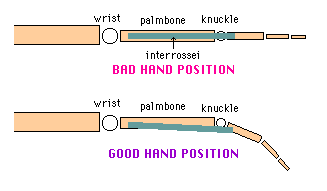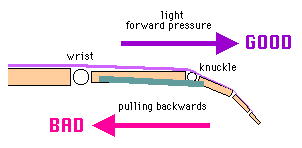To develop the Interossei muscles you must :
-
Always play with a good hand position.
The knuckle joint is not straight but slightly flexed.

In this position the Interossei can function as starter muscles.
- Develop
Interossei muscle strength.
Through regular technique practice as outlined in my Piano Technique Course.
Gradually the Interossei will become stronger. You will notice this by a most peculiar feeling within the palms of your hands : the interossei, as they become thicker, are pushing out the palm bones widening your hands.
Once the interossei have become strong enough to support the hand and arm it is time for the flexors and lumbricals to phase out their action. This mental step of trusting your fingers was for me at the time the most difficult process.
Sooner or later however the brain will get the message and gradually diminish and relax the flexors and let the interossei do the work . This then frees up the wrist, enabling the development of tone, resonance, clarity, great evenness and fluency in your playing.
Just playing piano regularly does not necessarily strengthen the Interossei muscles.
But sustained regular practice of the right exercises in the correct way will.
(Down - Up - Top)
PS 5 - Fundamental Guidelines
Good piano technique maximises the use of two sets of muscles.
- The Interossei, to support the weight of the hand, arm or body and to assist when required to the gravity keystroke.

- the Extensors Digitorium, to lift the fingers off the keyboard after they have played each note.
(Extensor Digitorium actions do not stiffen the wrist, as the natural weight of the hand prevents any upwards flexing or instability of the wrist.)
For a good finger technique follow these simple guidelines :
- Keep the hands always over the keyboard (not in front of it) with the thumbs pointing downwards, so that the weight of the hand is supported by the fingers (Interossei).
- Keep the hands balanced on the fingers, with a slight forward pressure towards the piano. (This keeps the finger joints locked in position.)

Never pull the hand backwards, for this either causes the fingers to collapse, or, in an attempt to prevent this, will bring the Flexor Digitorium muscles into action causing stiffening of the wrist.
- Use the knuckle joints for all finger action.
- Use gravity, viz. the natural drop of the finger, hand or arm, as the main source of energy.
It is most useful to have some understanding of the the muscle actions for a good finger technique.
However do not become obsessive about it while practising.
Just follow the simple instructions, lesson schedules and exercises provided in my Piano Technique Course (at your own pace) and things will fall into place and develop naturally.
(Up - Top - Jazclass Links)
© 2004 Michael Furstner (Jazclass)